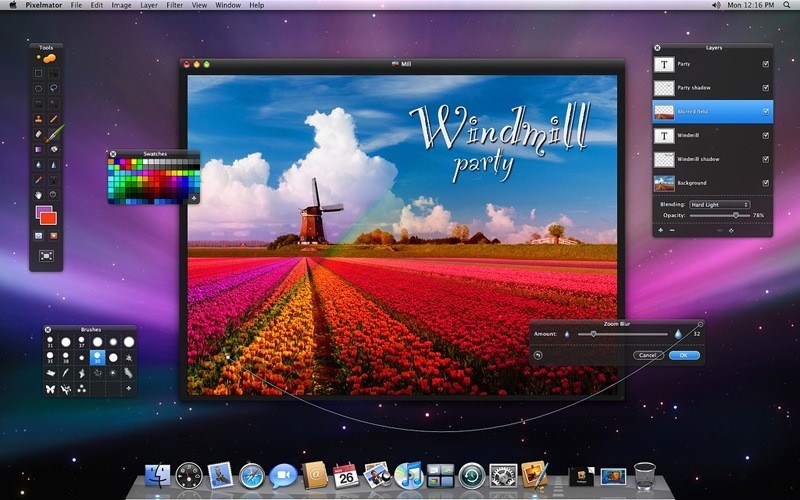
- #Pixelmator pro vs pixelmator photo manual
- #Pixelmator pro vs pixelmator photo pro
- #Pixelmator pro vs pixelmator photo software
#Pixelmator pro vs pixelmator photo software
However, they have much in common.Īcorn is a photo editing software for beginners that is great for fixing lighting issues.
#Pixelmator pro vs pixelmator photo pro
Pixelmator Photo costs $4.99/£4.99 and you can get it from the Apple App Store (opens in new tab).If you are interested in a comprehensive Acorn vs Pixelmator Pro comparison, in this review, I will tell you about the weak and strong sides of each program, so you won’t need to spend time testing each of them.Ĭurrently, both programs are not so popular among photographers and digital artists.

Pixelmator Photo is a snip at just $4.99/£4.99 but it’s best for people who just want quick fixes and all the benefits of machine-learning artificial intelligence rather than in-depth adjustments. And the regular Pixelmator is a more powerful all-in-one photo-editing, drawing, painting and illustration tool at the same price. Google Snapseed (opens in new tab) offers a far wider range of effects and adjustments, including local adjustments, and it’s free. The editing tools are great as far as they go, especially the film presets and perspective corrections, but with no local adjustments or layers tools (you need the ‘other’ Pixelmator for that), Pixelmator Photo feels quick, cheap and useful, but also a bit limited. You can’t launch Pixelmator Photo direct from the Apple Photos app, so that means you have to start from the app and import from Photos – it sounds a small thing, but it is annoying. The repairs aren't always invisible, but people who haven't seen the original photo probably won't suspect a thing. You might not use half of them, relying on the film emulation presets and key Lightness and White Balance settings instead, but they’re there if you want to experiment with more advanced image effects – and you can save your own custom presets.
#Pixelmator pro vs pixelmator photo manual
The manual adjustments are straightforward and responsive too. Pixelmator Photo automatically crops the image as you make adjustments so you don’t get any messy perspective correction ‘wedges’ at the side of the picture. The ML Crop tool is a nice idea that you can find yourself using more and more as you learn to trust the app to get your composition right, and the perspective correction sliders are smooth and responsive. The ML Enhance button can take a couple of seconds to do its work, as can the Repair too, but it feels quick compared to desktop software. Pixelmator comes with a wide range of film emulation presets, which work intelligently with any ML (machine learning) adjustments you've already made. If you want direct file compatibility between Pixelmator images on your iPad and the desktop software, you need the Pixelmator iOS app, not Pixelmator Photo. It doesn’t appear to use the same file format as the regular desktop Pixelmator Pro app, unfortunately, so editing Pixelmator Pro files on your desktop doesn’t look like it’s possible right now. Pixelmator Photo will also open raw files directly, from over 500 camera models. What this means is that you can use Pixelmator Photo to edit any image stored in these locations, so it’s like having a handy iPad editor for images available everywhere, including your desktop computer or laptop. You can store Pixelmator Photo files separately on your iPad or in Cloud locations like iCloud Drive or Dropbox (though it wouldn’t import a new file with the Dropbox option selected – Pixelmator is aware of this). On the upside, Pixelmator Photo is not tied to Apple Photos. Pixelmator Photo works independently of the Apple Photos app, so it makes importing and editing images more long-winded but gives you more choice in where you keep your images. This feels like a clumsy workflow (it’s the same for Google Snapseed), but Pixelmator Photo uses its own file format to allow its reversible non-destructive editing, so this is presumable how it has to work. Instead, you have to open Pixelmator Photo, import the photo you want from Apple Photos, edit it, then save it back out to Apple Photos. But Pixelmator Photo doesn’t appear on the list of options.
In an ideal world you might want to browse through your pictures in the Apple Photos app, choose one you want to edit and tap the ellipsis (…) button to choose the program to edit it with. If you want layers and selections, you need the Pixelmator app, sold separately. If you tap the tools icon, you can start making adjustments manually, with panels for Black & White, Fade, Lightness, Channel Mixer settings and many more – but with no selection or layers tools, all your adjustments will apply to the whole picture. The ML Crop option is a nice idea for those not confident about their own cropping/compositional skills, and the Crop screen also has Straighten and horizontal and vertical Perspective tools – that’s really useful for wonky travel shots and landmarks. The ML Crop tool will select an image composition automatically, and there are extremely useful perspective tools for straightening skyscrapers and other landmarks.


 0 kommentar(er)
0 kommentar(er)
